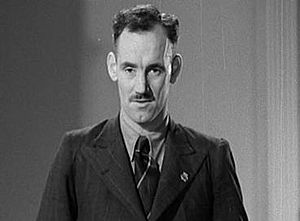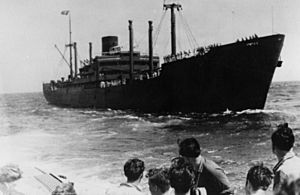Frank Laskier facts for kids
Quick facts for kids
Frank Laskier
|
|
|---|---|

Seaman Frank in a 1941 newsreel describes losing his foot to machine gun fire. "Do you think I'm going to let them get away with that?" he vows, "Not pygmalion likely!"
|
|
| Born | 1912 New Brighton, England,
|
| Died | 8 July 1949 (aged 36–37) New York City, New York, U.S.
|
| Occupation |
|
| Employer | Merchant Navy |
Frank Geoffrey Laskier (1912 – 8 July 1949) was a brave British sailor. He became famous during World War II. In 1940, his ship was attacked by a German warship. He was rescued after two days on a raft. Back in Britain, he shared his amazing story on BBC radio.
His broadcasts, called "My Name is Frank," were very popular. They helped people understand the war. They also encouraged more people to join the Merchant Navy. This was a group of ships that carried supplies during the war.
Frank became known as "Seaman Frank." He appeared in newsreels and gave talks. He also wrote books about his life. After the war, people slowly forgot about him. He died at age 37 in a car accident in New York City.
Contents
Frank Laskier's Early Life and Adventures

Frank Laskier was born in New Brighton, England. He grew up near the busy docks of Liverpool. When he was just 15 years old, he left home. For the next ten years, he traveled the world. He worked on many different merchant ships.
A Dangerous Attack at Sea
In late 1940, Frank was working as a gunner on a ship called the Eurylochus. His ship was attacked by a German warship, the Kormoran. This happened off the coast of West Africa. Frank was badly hurt and lost a foot from machine gun fire.
He spent two days on a raft in the ocean. He had no water and had to keep sharks away. Luckily, a Spanish ship rescued him and the other survivors. Frank was then sent back to Britain.
Becoming a Radio Star
In Liverpool, a BBC radio producer heard Frank telling his story. The producer asked Frank to share his adventure on a radio show. This show was called Postscript. Frank's story was first broadcast on October 5, 1941.
His powerful story reached many listeners. People loved hearing about his bravery. The newspapers praised him, and he became a hero.
"Seaman Frank": A Wartime Hero
Frank's stories were so popular that they were made into a book. It was called My Name is Frank (1941). A reviewer said his broadcasts had "the stuff of greatness." They felt his writing truly captured a sailor's life.
Soon, Frank appeared in films. These films were made to encourage people to join the Merchant Navy. He also traveled around the United States, giving talks.
Frank's Message of Courage
In one film, Seaman Frank Goes Back to Sea, Frank bravely re-joins the Merchant Navy. The narrator calls him a "real Englishman" doing his duty. In another film from 1941, Frank talks about wanting to fight again. He wanted to get revenge for his friends who died.
He famously said about losing his foot: "Do you think I'm going to let them get away with that? Not pygmalion likely!" This showed his strong spirit.
Life After the War
Frank wrote a second book, Log Book (1942). It was like a story but based on his own life. A reviewer called it "a work of art." After the war, Frank moved to the United States. He tried to make a movie about his life, but it didn't happen.
His last book, Unseen Harbor, was published in 1947. It was a made-up story. Frank Laskier died on July 8, 1949, in a car accident. He was only 37 years old.
Today, Frank Laskier is not as well-known. Some people see him as a wartime symbol. But his books are still praised. Many feel his writing truly shows what life was like for a sailor during the war.
Frank Laskier's Books and Recordings
- Seaman Frank Laskier Describes His Experiences (1941) – This was a recording of his famous radio show.
- My Name Is Frank (1941) – This book contained the stories from his BBC radio shows.
- Log Book (1942) – An autobiographical novel, meaning it was a story based on his own life.
- The Call of the Sea (1942) – A film where Frank was the narrator.
- Unseen Harbor (1947) – A novel.

